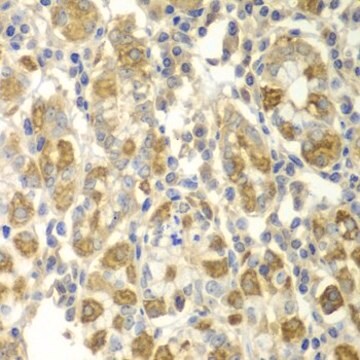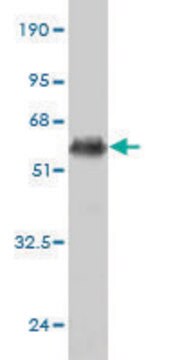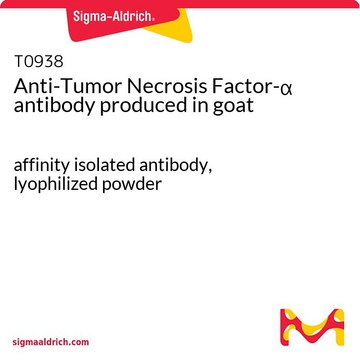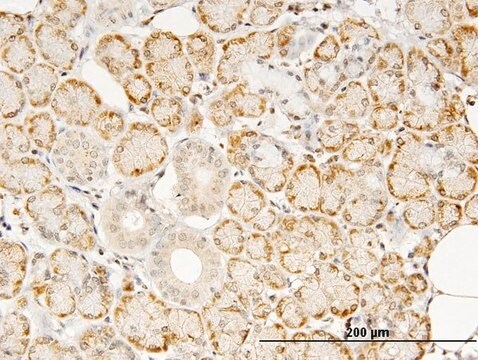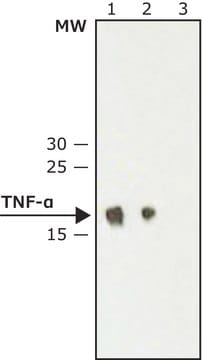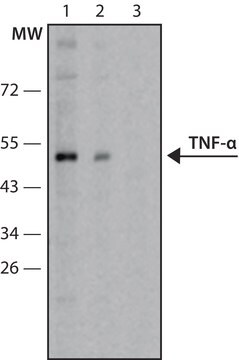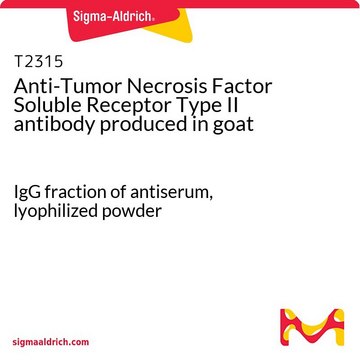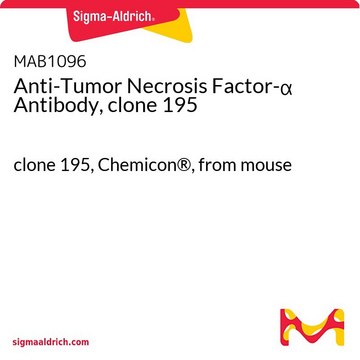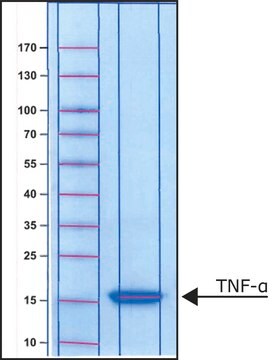T3198
Monoclonal Anti-Tumor Necrosis Factor-α antibody produced in mouse
clone 45418.111, purified immunoglobulin, lyophilized powder
Sinonimo/i:
Anti-TNF-α
Autenticatiper visualizzare i prezzi riservati alla tua organizzazione & contrattuali
About This Item
Prodotti consigliati
Origine biologica
mouse
Livello qualitativo
Coniugato
unconjugated
Forma dell’anticorpo
purified immunoglobulin
Tipo di anticorpo
primary antibodies
Clone
45418.111, monoclonal
Stato
lyophilized powder
Reattività contro le specie
rat
tecniche
capture ELISA: suitable
neutralization: suitable
western blot: 1-2 μg/mL
Isotipo
IgG1
N° accesso UniProt
Temperatura di conservazione
−20°C
modifica post-traduzionali bersaglio
unmodified
Informazioni sul gene
rat ... Tnf(24835)
Descrizione generale
The antibody has the ability to neutralize the biological activity of rat TNF-α.and may also be used as a capture antibody in ELISAs.
Immunogeno
purified recombinant rat TNF-α expressed in E. coli.
Applicazioni
Monoclonal Anti-Tumor necrosis factor-α antibody produced in mouse has been used in immunoneutralization study and western blot analysis.
Azioni biochim/fisiol
Tumor Necrosis Factor-alpha (TNF-α) is a cytokine produced by macrophages in response to stimulus by LPS. It plays a major role in mediating inflammation, tissue injury, pathogenic shock, innate immunity, apoptosis and autoimmunity. The physiological effects of TNF-α are mediated by receptors of Tumor necrosis factor receptor (TNFR) super family. TNF/TNFR also results in the activation of downstream pathways involving mitogen-activated protein kinase (MAPK), p38(a class of MAPK), c-Jun N-terminal kinase (JNK) and NF-κB (Nuclear Factor kappa-light-chain-enhancer of activated B cells) that play a major role in innate immunity, acute inflammatory responses and homeostasis.
Tumor necrosis factor-α (TNFα) affects various cellular processes such as blood-brain barrier, inflammatory, thrombogenic and vascular changes following brain damage. TNFα expression is upregulated in various central nervous system disorders, including Alzheimer′s disease, multiple sclerosis, Parkinson′s disease, meningococcal meningitis and human immunodeficiency virus (HIV) infection. Elevated expression of TNFα in the brain and blood in response to lipopolysaccharide might increase brain stem thrombosis, hemorrhage and stroke sensitivity/risk in hypertensive rats. Tumor necrosis factor-α activates polymorphonuclear leukocyte NADPH oxidase, thereby facilitates development of systemic oxidative stress (OS), inflammation and hypertension in rats.
Tumor necrosis factor-α (TNFα) affects various cellular processes such as blood-brain barrier, inflammatory, thrombogenic and vascular changes following brain damage. TNFα expression is upregulated in various central nervous system disorders, including Alzheimer′s disease, multiple sclerosis, Parkinson′s disease, meningococcal meningitis and human immunodeficiency virus (HIV) infection. Elevated expression of TNFα in the brain and blood in response to lipopolysaccharide might increase brain stem thrombosis, hemorrhage and stroke sensitivity/risk in hypertensive rats. Tumor necrosis factor-α activates polymorphonuclear leukocyte NADPH oxidase, thereby facilitates development of systemic oxidative stress (OS), inflammation and hypertension in rats.
Stato fisico
Lyophilized from a 0.2 μm filtered solution in phosphate buffered saline containing carbohydrates.
Esclusione di responsabilità
Unless otherwise stated in our catalog or other company documentation accompanying the product(s), our products are intended for research use only and are not to be used for any other purpose, which includes but is not limited to, unauthorized commercial uses, in vitro diagnostic uses, ex vivo or in vivo therapeutic uses or any type of consumption or application to humans or animals.
Non trovi il prodotto giusto?
Prova il nostro Motore di ricerca dei prodotti.
Codice della classe di stoccaggio
11 - Combustible Solids
Classe di pericolosità dell'acqua (WGK)
WGK 3
Punto d’infiammabilità (°F)
Not applicable
Punto d’infiammabilità (°C)
Not applicable
Dispositivi di protezione individuale
Eyeshields, Gloves, type N95 (US)
Scegli una delle versioni più recenti:
Possiedi già questo prodotto?
I documenti relativi ai prodotti acquistati recentemente sono disponibili nell’Archivio dei documenti.
Pallavi Shrivastava et al.
Journal of neuroinflammation, 14(1), 83-83 (2017-04-15)
Opioid receptors are known to control neurotransmission of various peptidergic neurons, but their potential role in regulation of microglia and neuronal cell communications is unknown. We investigated the role of mu-opioid receptors (MOR) and delta-opioid receptors (DOR) on microglia in
Effects of IFN-β1a and IFN-β1b treatment on the expression of cytokines, inducible NOS (NOS type II), and myelin proteins in animal model of multiple sclerosis.
Lubina-Dabrowska N, et al.
Arch. Immunol. Ther. Exp., 65(4), 325-338 (2017)
Alleviation of hepatic steatosis accompanied by modulation of plasma and liver TNF- levels by Trigonella foenum graecum (fenugreek) seeds in Zucker obese (fa/fa) rats.
Raju J, and Bird R P
International Journal of Obesity, 30(8), 1298-1298 (2006)
Tumor necrosis factor-alpha: a possible priming agent for the polymorphonuclear leukocyte-reduced nicotinamide-adenine dinucleotide phosphate oxidase in hypertension.
Mazor R, et al
Hypertension, ;55(2), 353-362 (2010)
Mu-opioid receptor and delta-opioid receptor differentially regulate microglial inflammatory response to control proopiomelanocortin neuronal apoptosis in the hypothalamus: effects of neonatal alcohol.
Shrivastava P, et al.
Journal of Neuroinflammation, 14(1, 83-83 (2017)
Il team dei nostri ricercatori vanta grande esperienza in tutte le aree della ricerca quali Life Science, scienza dei materiali, sintesi chimica, cromatografia, discipline analitiche, ecc..
Contatta l'Assistenza Tecnica.